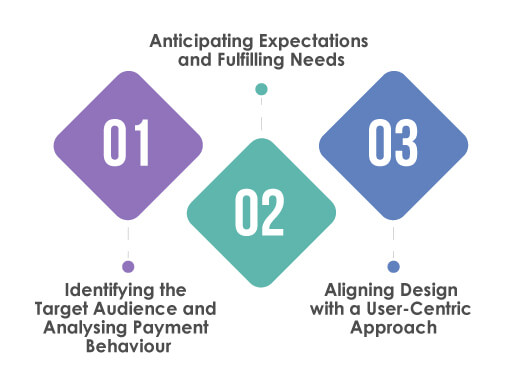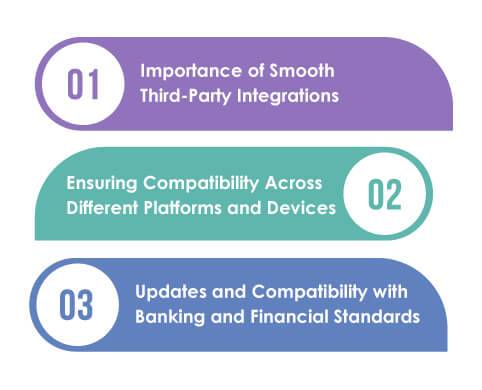
In today’s digital landscape, user experience is a cornerstone of success for any application. It is especially true in the case of digital payment applications. As more people adapt to the convenience and efficiency of digital payments, ensuring a seamless and user-friendly experience has become crucial. A study has projected that global cashless transactions will surge to nearly 1.9 trillion by 2025, marking an impressive 80% surge from the 2020 statistics.
User experience is a critical factor that can determine the success or failure of a digital payment application. Imagine a scenario where payment involves a complicated process, unclear instructions, and a heavy interface. Such a situation would deter users from adopting the application, leading to frustration and potentially driving them towards competing platforms.
A seamless user experience introduces confidence and trust in users. When payments are processed smoothly and securely, users feel more inclined to use the application repeatedly. This trust factor is especially crucial in digital payments, where concerns about security and privacy are prevalent.
Understanding the User’s Perspective
A deep understanding of the user’s perspective is essential to ensure a seamless user experience within digital payment applications. Let’s look into the critical aspects of comprehending the target audience’s behaviour and anticipating their expectations and needs, ultimately enhancing the overall user experience:
Identifying the Target Audience and Analysing Payment Behaviour
The base for creating an exceptional user experience lies in knowing your audience. Start by pinpointing key demographics such as:
• Age groups
• Geographical locations
• Socio-economic backgrounds.
This information provides insights into the diversity of users the application will serve. Furthermore, understanding their payment behaviour is necessary. Recognise the preferred methods of payment, transaction frequency, and contextual usage. Younger generations might gravitate towards innovative payment methods and digital wallets, while older users could prioritise simplicity and clarity in navigation.

Anticipating Expectations and Fulfilling Needs
Users anticipate intuitive interactions and efficient processes when managing their finances through digital applications. One effective strategy involves taking user feedback and conducting surveys. It can uncover pain points and critical needs, providing actionable insights for enhancements. Additionally, keeping an eye on industry trends allows for integrating forward-thinking features that enhance the user experience.
Aligning Design with a User-Centric Approach
User-centric design involves crafting intuitive, efficient, and visually appealing interfaces. Elements like straightforward navigation, concise instructions, and pleasant visuals create a positive user experience.
By having an in-depth knowledge of user behaviour with a design that caters to their preferences, businesses can establish trust and loyalty among users. A user-centric approach bridges the gap between user expectations and the application’s functionality, enhancing user experience.
Design Principles for Seamless Experience
Creating a seamless user experience in digital payment applications requires a strategic application of design principles. Let’s look into crucial design considerations that can elevate user satisfaction and streamline their interactions:

Simplicity in Design and Navigation
A clutter-free interface with a clear information hierarchy enhances visual appeal and facilitates intuitive navigation. Users should be able to perform tasks with minimal effort and without feeling confused. Strive for a design that guides users effortlessly through the payment process, reducing cognitive load and enhancing overall user satisfaction.
Ensuring Speed and Reliability
Slow-loading pages and unreliable processing can lead to frustration and mistrust. Employ efficient coding practices to optimise application performance. Minimise unnecessary steps and loading times to ensure swift interactions. Prioritise secure connections to gain users’ confidence, reassuring them that their transactions are protected.
Creating Intuitive User Interfaces
An intuitive user interface anticipates user actions and presents options logically. Utilise familiar patterns and design elements that users can instinctively recognise and interact with. Intuitive interfaces minimise the learning curve, enabling tech-savvy users and those less familiar with technology to navigate effortlessly. Visual cues, such as progress indicators and logical grouping of elements, enhance user understanding and guide them through the payment journey.
Providing Clear Call-to-Action Elements
The effectiveness of a digital payment application relies on clear and strategically placed call-to-action (CTA) elements. These buttons or prompts guide users towards completing desired actions, such as making payments or confirming transactions. Ensure CTAs stand out visually while contrasting with the overall design. Use informative text to convey the action the user is taking. Strategically position CTAs at points where user interaction is needed, minimising confusion and maximising engagement.
Security Without Compromising Usability
Security is an important concern in digital payments, but it should not come at the expense of usability. Balancing robust security measures with a user-friendly experience is feasible and crucial to providing a safe and seamless transaction environment. Following are some practices to create a reliable and user-centric digital payment ecosystem:

Importance of Trust in Digital Payments
Users entrust sensitive financial information to these platforms, necessitating a profound commitment to security. Building trust involves safeguarding user data by implementing security protocols for data protection. Users must feel confident that their transactions are protected from cyber threats, enabling them to engage with the application without hesitation.
Implementing Advanced Encryption Techniques
Encryption guards sensitive data against cyber criminals. Employing advanced encryption techniques ensures that user information remains indecipherable to unauthorised entities. From end-to-end encryption during data transmission to secure storage practices, these measures reinforce the perception of a safe environment, building user confidence in the application’s integrity.
User Authentication and Authorization Measures
Authentication and authorisation mechanisms are the gatekeepers that control access to digital payment platforms. Multi-factor authentication, biometric recognition, and strong password policies enhance user identity verification, protecting the system against fraud. Striking a balance between robust security and user convenience is essential, as stringent measures should allow users to access their accounts.
Educating Users on Security Best Practices
Empowering users with knowledge is a potent tool against security breaches. By educating users about common threats and best practices, such as avoiding suspicious links and regularly updating passwords, digital payment applications can nurture a proactive user community that actively participates in safeguarding their data.
Integration with Other Platforms and Services
The smooth functioning of a digital payment application depends on its ability to integrate with various platforms and services. Its capabilities are measured by its seamless integration with multiple platforms and services.

Importance of Smooth Third-Party Integrations
The modern digital landscape works on interconnectedness. Integrating digital payment applications seamlessly with third-party platforms enhances user convenience and extends the application’s functionality. Whether it’s e-commerce websites, mobile apps, or other digital services, the ability to facilitate transactions across diverse platforms creates a cohesive and efficient user journey.
Ensuring Compatibility Across Different Platforms and Devices
User experience does not depend on a single device or platform. Cross-platform compatibility is essential for users interacting with the application across various devices, such as smartphones, tablets, and desktops. A consistent and responsive interface across different platforms contributes to user satisfaction, enabling them to engage with the application on their preferred devices.
Updates and Compatibility with Banking and Financial Standards
The dynamic nature of the finance industry necessitates ongoing updates and compatibility with banking and financial standards. Timely updates ensure compliance with changing regulations and industry standards. Moreover, seamless integration with these institutions guarantees smooth transaction processing, improving user trust and reducing the chances of payment-related issues.
Role of Digital Payment Application Testing
Behind every seamless digital payment experience is a robust testing process that ensures flawless functionality, uncompromised performance, impregnable security, and enhanced usability. Let’s look into the role of testing in digital payment applications, outlining the key areas of focus that culminate in an application that is user-centric and operationally impeccable:

Ensuring Functional Correctness
Testing various features, such as account creation, transaction processing, and payment confirmation, guarantees that the application behaves precisely as intended. The functional testing phase minimises the risk of errors and improves user confidence in the application’s reliability.
Performance and Load Testing
Performance is a key factor in a digital payment environment characterised by swiftness. Rigorous implementation and load testing simulate various usage scenarios, ensuring the application remains responsive even under heavy user traffic. It prevents potential bottlenecks and upholds user satisfaction, as transactions are processed swiftly and seamlessly.
Security Testing and Vulnerability Scans
The digital payment platform is a prime target for malicious attacks, making security testing necessary. Penetration testing and vulnerability scans uncover application security weaknesses and identify potential entry points for cyber threats. Ensuring user data remains encrypted and invulnerable ensures user trust and safeguards their financial information.
Usability Testing for Enhancing the User Experience
A user-centric design is validated through usability testing. This process involves real users navigating the application and capturing feedback on their experience. Insights gained from usability testing drive refinements, ensuring that navigation is intuitive, instructions are clear, and interactions are seamless. This iterative approach contributes to an application that aligns with user expectations.
Why Partner with TestingXperts for Digital Payment App Testing?

Are you ready to enhance your digital payment app’s performance, security, and user satisfaction? At TestingXperts, we specialize in comprehensive testing solutions tailored exclusively for digital payment applications. Our cutting-edge testing methodologies and industry expertise ensure your app stands out in the competitive digital payment landscape.
Key Differences That Set Us Apart
Specialised Domain Knowledge: Our team comprises QA experts with a deep understanding of the processes of digital payment applications. It enables us to identify potential pitfalls and optimise every feature of your app.Strategic Approach to Testing: Our testing approach covers functional correctness, performance, security, and usability. This comprehensive methodology ensures that your app meets industry standards and exceeds user expectations.
Usability Testing
A user-centric design is at the core of a successful digital payment application. Our usability testing goes beyond the basics, looking into user behaviour analysis, intuitive navigation assessment, and feedback-driven enhancements that improve the user experience.
Digital Test Lab
Our Digital Test Lab is equipped with the latest devices, platforms, and technologies, providing access to various devices for compatibility testing purposes.
Robust Security Testing:
The security of user data and financial transactions is non-negotiable. Our advanced security testing and vulnerability scans identify potential threats, ensuring your app is ready against cyber risks and user data remains protected.
Performance Testing
In an industry where speed is crucial, our performance testing evaluates your app’s responsiveness under various conditions, ensuring smooth and swift transaction processing, even during peak usage.
Continuous Adaptation and Improvement
We understand that staying relevant means staying ahead. Our constant monitoring and adaptation ensure that your app remains resilient, up-to-date, and aligned with the latest industry trends.
Conclusion
In the rapidly evolving digital payment industry, a seamless user experience has driven innovation and progress. It depends on simplicity, intuitiveness, and the anticipation of user needs. Also, integrating third-party platforms and services expands the app’s horizons, catering to various user needs. The rigour of testing, from functional correctness to security fortifications, ensures an application that is not just operational but resilient, ready to face the complexities of the digital landscape. Contact our experts now to know more about digital payment app testing services.
Discover more
Get in Touch
Stay Updated
Subscribe for more info




